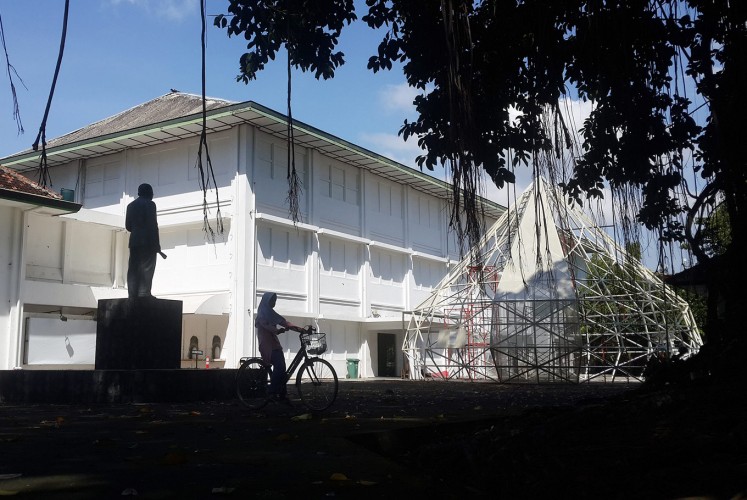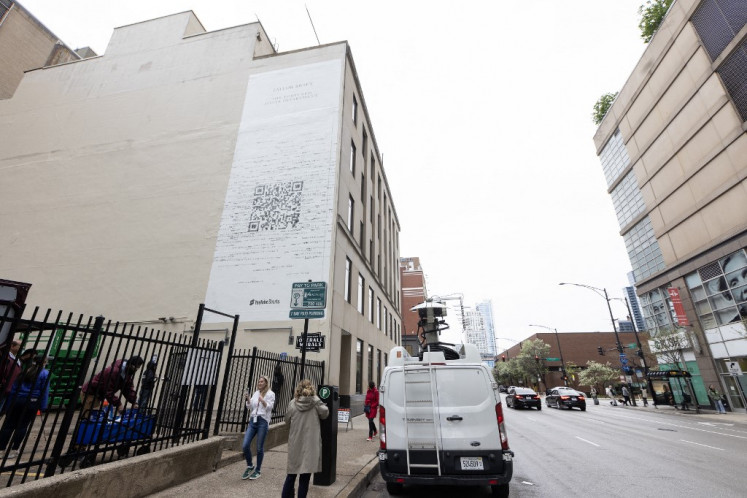Jogja National Museum: Always a home for the country's contemporary art
The building is a silent witness to the development of fine art in Indonesia.
Change Size
 The center of attention: A giant frame in the shape of a diamond, which will be a terrarium for the work of commissioned artist Mulyana, is seen outside the Jogja National Museum in Yogyakarta. (JP/Bambang Muryanto)
The center of attention: A giant frame in the shape of a diamond, which will be a terrarium for the work of commissioned artist Mulyana, is seen outside the Jogja National Museum in Yogyakarta. (JP/Bambang Muryanto)
E
very time he visits the Jogja National Museum, Leo Mulyono, 73, says he always remembers the moment he was admitted to the Indonesian Fine Arts Academy (ASRI), where he majored in graphic illustration back in 1963.
The three-story building located in Gampingan, Wirobrajan district, Yogyakarta, was once the ASRI campus.
“I remember the day when I was told to run around the square behind the building during Ospek [an initiation program for new students]. It was Amri Yahya who told me to do so,” Leo told The Jakarta Post, referring to the late fine artist who was also a former ASRI student and lecturer.
The square is no longer there as other buildings have been built on the site. The 1.4 hectare compound is shaded thanks to a number of big trees.
Leo said when he was an ASRI student, there had only been one building in the compound, which currently serves as the museum’s main exhibition venue. The first and third floors were classrooms, while the second floor contained rooms for the academy’s leaders, an administration office and a library.
“The building physically remains the same. Only the interior is different because it has been turned into exhibition rooms,” Leo added.
It is in this building that the biggest fine art market in Indonesia, the 11thARTJOG, will be held from May 4 to June 4, taking “Enlightenment — Toward Various Futures” as its theme.
Read also: ARTJOG: Window to Indonesian arts
Heri Pemad, the founder of Heri Pemad Art Management (HPAM) and the organizer of ARTJOG, said 65 artists would exhibit their artwork at the annual event. Organized for the first time in 2008, ARTJOG was initially held at the Yogyakarta Cultural Park. It was moved to the museum in 2016.
“We have no representative building and infrastructure for ARTJOG here in Yogyakarta. I consider the museum as the most suitable so far,” Pemad added.
The first time ARTJOG was moved to the museum, the first thing that Pemad did was to erect the words ASRI on the building.
A year later, he installed the statue of the first director of ASRI, RJ Katamsi (1950-1958), in the northeast corner of the building. The statue was the work of sculpture Wahyu Santosa and was presented by ARTJOG to show respect to RJ Katamsi and the history of ASRI.
“I was once a student of that place, so I have a personal drive to restore the site that is historical to the development of fine art in Indonesia,” Pemad said.
The museum’s building was built in 1950 and was used as an ASRI campus in 1957. The prefabricated building, built through sponsorship from the United States, became a witness to the development of fine art in Indonesia when ASRI was changed into the Indonesian Fine Art College (STSRI) in 1968, which later became the Indonesian Fine Arts Institute (ISI) in 1984.

Many big names in the world of art in Indonesia have walked the campus’ hallowed halls. Among them were Edhi Sunarso, Saptoto, Widayat, Amri Yahya as well as contemporary artists FX Harsono, Eddie Hara, Heri Dono and Dadang Christanto.
When the ISI campus was moved from Gampingan to Sewon, Bantul regency, Yogyakarta, in 1995, the building became empty and it was used as a base camp for the Taring Padi art community.
In the book entitled Taring Padi Praktik Budaya Radikal di Indonesia (Taring Padi the Practice of Radical Culture in Indonesia), Heidi Arbuckle writes that Taring Padi used the place to live collectively, creating works, planting vegetables and organizing art events by involving people from the surroundings.
In 2006, Yayasan Yogyakarta Seni Nusantara started renovating the building and managing it as an enclave for art and cultural activities. Since then, the museum has turned into a place for all kinds of art activities including art exhibitions, music performances, and others.
“I cooperated with the government to open a museum for contemporary arts that Yogyakarta needs, which is the Jogja National Museum,” said its executive director, Kanjeng Pangeran Haryo (KPH) Wironegoro.
Over the weekend, dozens of workers from HPAM were seen busy preparing the venue at the museum for the fine art market. A diamond-shaped iron structure of about 7 meters in height has already been installed in front of the main exhibition room. It is a terrarium for the knitting work of commissioned artist Mulyana “Mogus” entitled Sea Remembers.
In the main building, workers were also seen renovating and preparing for the exhibition rooms located on the first and second floors. Meanwhile, workers in the southern part of the building were preparing the stage and exhibition rooms at the Pendopo Ajiyasa hall.
Pemad said the challenge in preparing the ARTJOG venue was modifying the rooms inside the building, which are small and rigid, to make them comfortable to display world class contemporary artworks.
“Many important world class artists failed to join ARTJOG due to limited representative rooms to display their best works,” Pemad said, adding that among them was Damien Hirst, a noted British contemporary artist.
Pemad also complained about the lack of access for disabled people to the main exhibition rooms on the second and third floors of the building.
KPH Wironegoro said the museum had become an ideal place for exhibitions.
He added that among the things still needed at the facility were lighting, good air conditioners and a lift for disabled people.
“We are working together with the government to address the issue,” said KPH Wironegoro who is the son in-law of Yogyakarta Governor Sri Sultan Hamengkubuwono X.
Your Opinion Matters
Share your experiences, suggestions, and any issues you've encountered on The Jakarta Post. We're here to listen.
Thank you
Thank you for sharing your thoughts. We appreciate your feedback.









